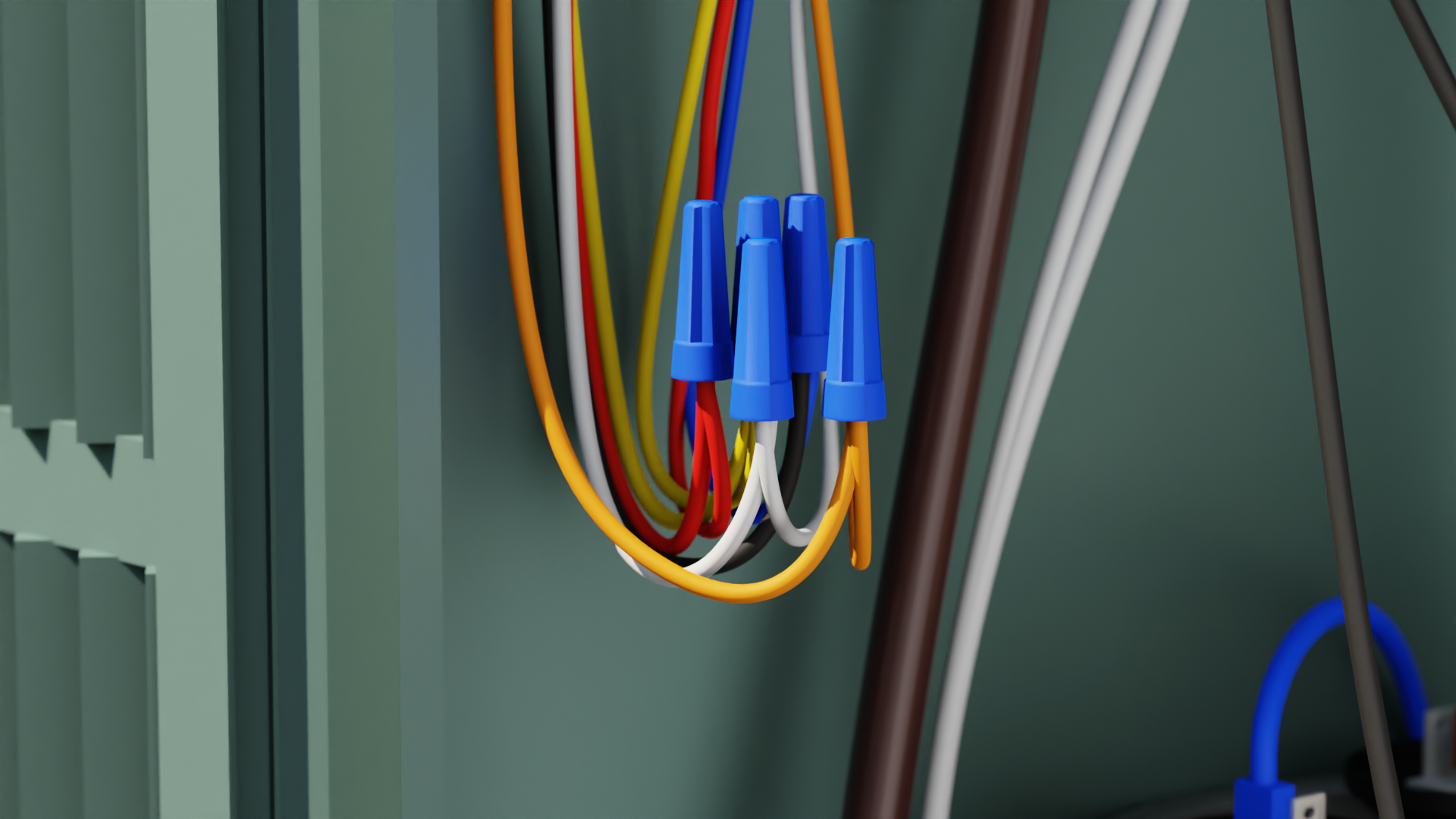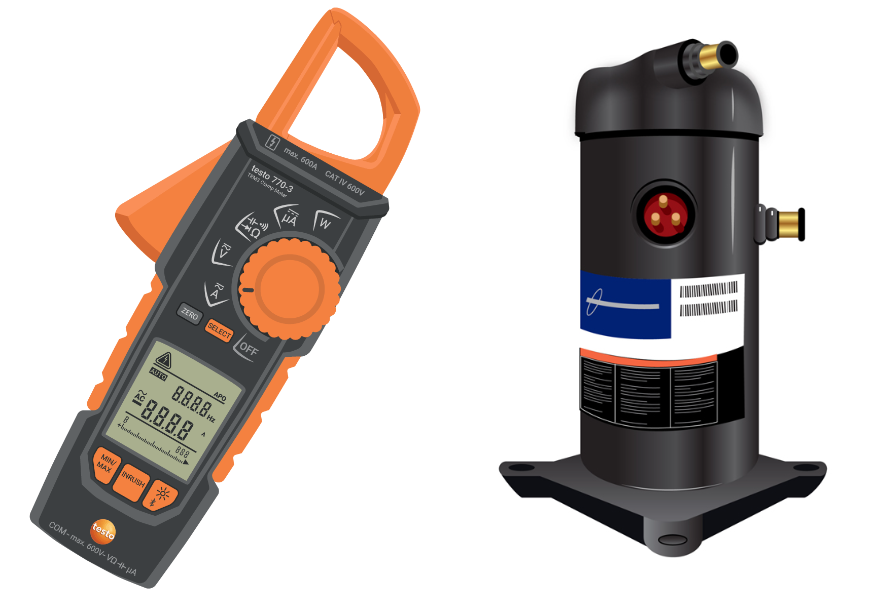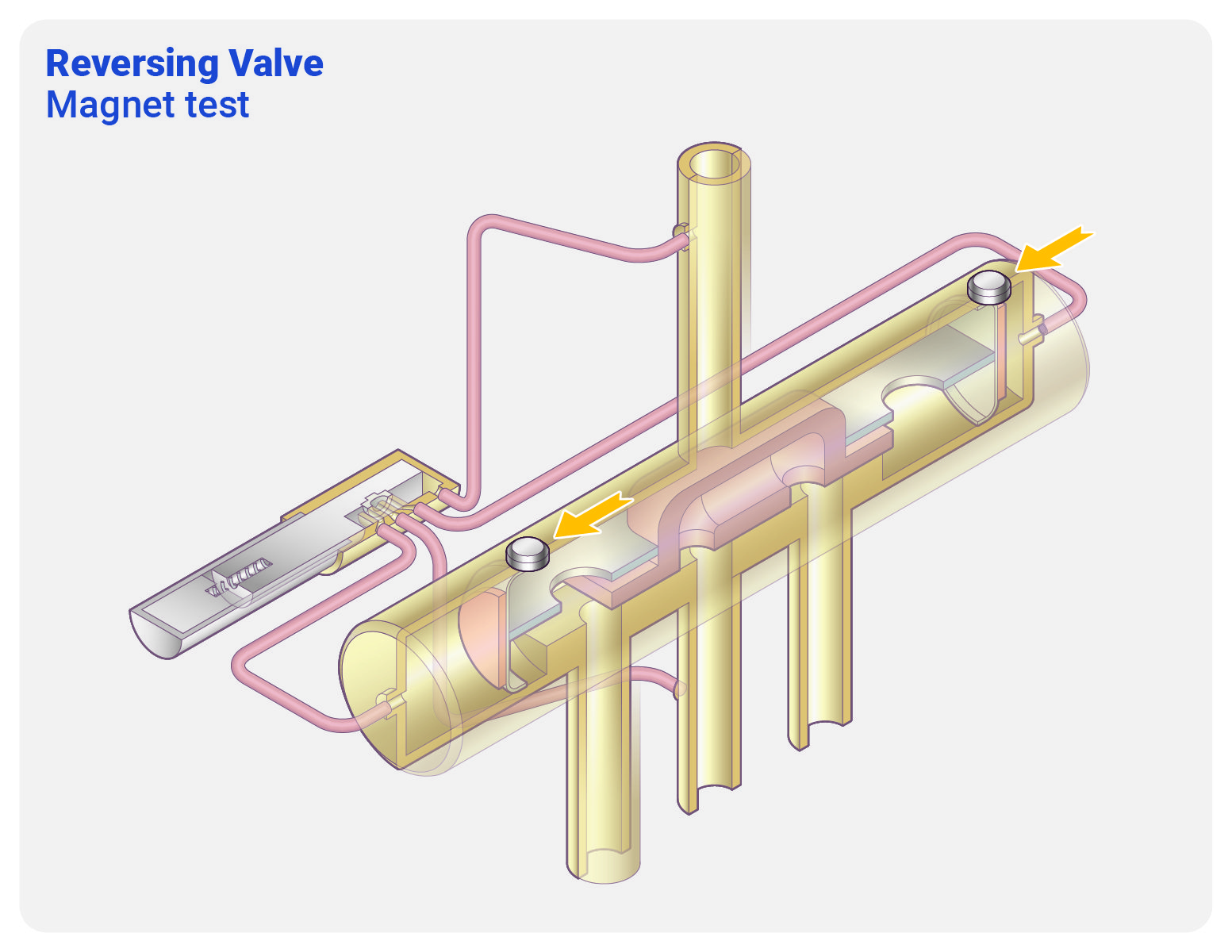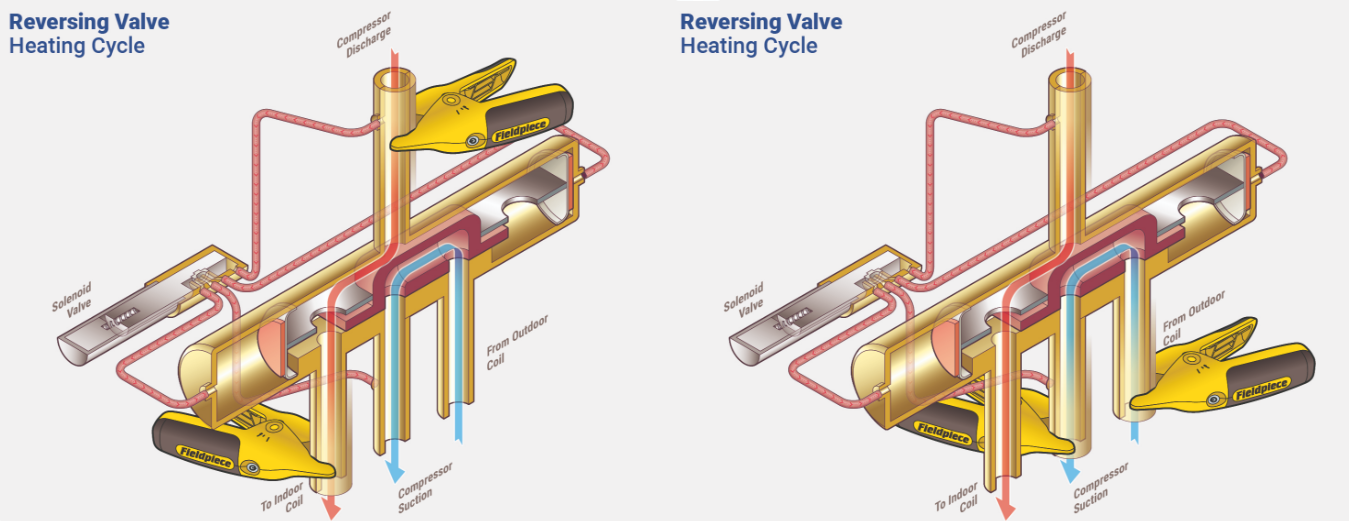Get Tech Tips
Subscribe to free tech tips.
Diagnosing a Reversing Valve
Introduction
Replacing a reversing valve is either every technician’s dream or nightmare. The sheer amount of brazing involved in confined spaces will inspire either delight or nightmares about the upcoming valve replacement. Fortunately, these emotional highs and lows are uncommon because we don’t diagnose and replace bad reversing valves very often.
That itself poses a challenge because the rarer a problem is, the less likely we are to feel confident diagnosing the issue; this is no capacitor replacement, folks. So, what are all of the diagnostic tools at our disposal when it comes to diagnosing a bad reversing valve? We need to start with the fundamentals and work forward from there.
How a Heat Pump Works

There are plenty of great articles and videos scattered across the HVAC School website to help you get into the basics of how a heat pump works. Check those out first if you need to start there.
Basically, a heat pump reverses the flow of refrigerant so that the indoor evaporator can act as the condenser and reject heat into the home. In cool mode, a heat pump functions the same as any other AC unit. In heat mode, a heat pump absorbs heat in the outdoor unit and rejects it from the indoor unit. Heat pumps can do this because they have a reversing valve.
The Reversing Valve

Again, there are specific articles available related to how the valve works. What we need to dig into here is what exactly happens when a reversing valve fails. You could have two types of failure: either electrical or mechanical. The mechanical shifting of the reversing valve is powered by a solenoid, which uses the system’s operating pressure to shift a “canoe” back and forth inside the valve. When that “canoe” shifts, it changes the refrigerant flow direction.
Ultimately, the question we are asking is: “Is there a mechanical or electrical failure in the reversing valve?” If the reversing valve has failed, either the solenoid has an electrical problem or the mechanical components inside the valve have malfunctioned in some way.
Thinking Like a Detective
The problem with both of these potential reversing valve failures is that you can’t see them. We have the same problem Sherlock Holmes does when it comes to solving mysteries.
Sherlock might have a trail of clues, like boot prints in a specific type of clay or a neighbor who heard shouting in the street right before a murder. We know the heat pump is dead (or at least not working as it should), or you wouldn’t be there.
The question is: who killed it? Is it the reversing valve, low charge, the outdoor metering device, the filter drier, or the compressor? The method outlined below is designed to eliminate all other possibilities using isolation diagnosis to prove that the reversing valve has failed.
The Homeowner
Ask the homeowner some good questions. How well has everything worked in the past? When did you notice this issue? Have you ever had problems like this before? Have there been any odd noises coming from the equipment? As a company or technician, have you been out to this home recently?
General System Check
Get familiar with the system. Check the filter, temperature differential, and airflow. At this stage, we are narrowing down the list of suspects as to who could be the “killer” of the system. You don’t want to do a ton of diagnostic work only to find out the filter was dirty or the supply duct you were measuring from is disconnected.
Refrigerant Charge

What should the charge look like when you put your gauges on a heat pump? In heat mode? AC mode? You need to know that first before you can see if anything is out of place. Does it operate normally in AC mode but cut off on high head pressure in heat mode? If you’re working on a system in heat mode, the door panel or outdoor manual will hopefully have a charging chart that you can reference.
On the most basic level, in cool mode, the condenser needs to be above the outdoor ambient temperature to “give” its heat to the outdoor air. Conversely, in heat mode, a system needs to be below the outdoor temperature in order to get/receive heat from the outdoor air. I recommend this article for more specifics on charge levels and this one for a heat pump if you don’t have a charging chart.
Electrical Component Checks

When you change the system from heat to cool, does the call for O/B change as well?
When running in the mode with the reversing valve energized (cool mode on most systems; Ruud/Rheem heat pumps energize the reversing valve in heat mode), disconnect the O/B wire from the control wire bundle and see what happens. If you hear the valve shift and see the pressures change, you can eliminate the control wiring and the solenoid on the reversing valve as the problem.
Amp Draw

What is your compressor amp draw? Compare it to the rated amp draw on the nameplate. Remember, amp draw is a measure of work being done by the compressor; with that in mind, does your amp draw seem high or low?
The amp draw changes based on the differential between the high and low sides of the system. The amp draw will be higher with a higher pressure differential from inside to outside. So, in heat mode, the compressor should be doing more work as it gets colder outside. What happens to the amp draw if you cover the condenser with a drop cloth while the system is running? Does the amp draw go up? Does it change at all?
If your amp draw seems abnormally low it could mean either the compressor is not working properly or the reversing valve is bypassing, as both mean the compressor isn’t doing much “work.” However, if you do the magnet test (we will get to this) and can verify the reversing valve is seated properly and then you have a low amp draw, that would indicate a failed compressor.
Pump Down Check
A pump down test is a test to make sure the compressor is compressing properly. Don’t do this test on microchannel coils, as those are not designed to be pumped down.
In cooling mode, valve off the high side of the system and see if the low side drops and the compressor draws the refrigerant back into the condenser. If you valve off the high side and the low side pressure doesn’t drop, this would be a dead giveaway that the compressor has failed.
Magnet Test

Credit for this diagnostic test goes to the tech support team at Century Supply in Dallas. The idea is to use rare earth magnets (you can buy them for a couple of dollars at Harbor Freight) to watch the “canoe” inside the valve shift back and forth. This test can give you a strong indication that the valve is performing correctly.
There is a Teflon gasket inside, so even if the metal is shifting properly, you could still have a leaking valve. But again, we’re collecting evidence, and the magnet test can be a big help. You’ll be able to tell if your valve is shifting at all, halfway, or all the way.
Temperature Differential Across the Valve

A few years back, Kaleb and Bryan discussed reversing valves in this podcast and mentioned checking for temperature differences across the valve as a way to diagnose a faulty reversing valve.
In theory, a reversing valve could be “bleeding” hot or cold refrigerant into the opposite side of the system. For example, let’s say you have a valve that’s not seated properly. Some cold refrigerant from the outdoor coil bleeds into the hot vapor line headed inside. You take temperature readings across the valve, and that uncontrolled mixing of hot and cold refrigerant within the valve gives you a temperature differential that you can measure with clamps on the copper.
The generally accepted temperature differential for a properly functioning valve from hot line to hot line or cold to cold is 3-5 degrees Fahrenheit. Anything more than that, and you’ve got refrigerant bleeding across a valve that isn’t properly seated. This RSES troubleshooting article goes much more in-depth about what your temperature differential across each line should be in specific modes. It also provides a line-by-line diagnostic procedure for reversing valves.

I would caution that this test can produce some false diagnoses if the compressor is not running properly. A damaged compressor can produce high temperatures on the discharge line that may conduct into the reversing valve body, especially after a long run time. This test, by itself, is not conclusive.
A Step-by-Step Process
There are a lot of different pieces of the puzzle discussed here, and much of how you approach diagnosing a bad reversing valve will depend on your particular situation. However, I find it very helpful to have a workflow for all of my processes. Each step of the process should eliminate other potential causes of a system not functioning properly. My recommended process to identify a bad reversing valve in heat mode would be:
1. Turn the system on and look over the whole system
- Eliminates issues like a dirty filter or poor airflow that may skew the rest of your diagnosis
2. Check the charge
- Will either indicate a charge issue or further investigation
3. Cycle the system from heat to cool
- Proves electrical components are sound
4. Perform the magnet test
- Rules out (most) mechanical issues within the valve
5. Check amp draw and perform pump down test
- Indicates compressor health or lack thereof
6. Check the temperature differential across the valve
- If everything else comes back with a clean bill of health and you have a temperature difference of more than 5 degrees across the valve, then the valve is bad.
—Matt Bruner











Comments
I had what i thought was a defective reversing valve…and what would happen…Heil Split Heat pump….and it would not defrost good….seems everytime i check it…everything was find….the finally one day…i found the problem….it had a TXV..and when it would go in defrost cycle….it would occasionally stick….no all them time…was hard to find problem
I had what i thought was a defective reversing valve…and what would happen…Heil Split Heat pump….and it would not defrost good….seems everytime i check it…everything was find….the finally one day…i found the problem….it had a TXV..and when it would go in defrost cycle….it would occasionally stick….no all them time…was hard to find problem
Those are tricky problems! Glad you figured it out
Those are tricky problems! Glad you figured it out
To leave a comment, you need to log in.
Log In